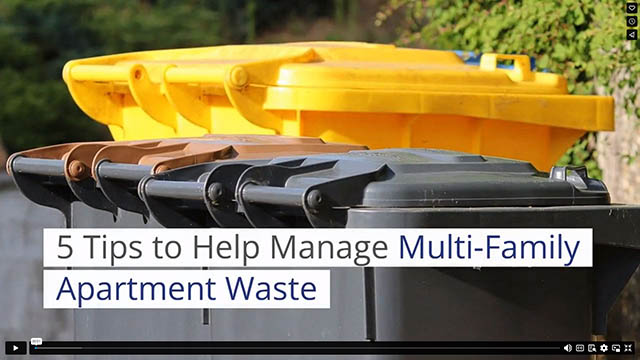5 Tips to Help Manage Multi-Family Apartment Waste
In 2019, the US Census statistics revealed that almost one-third of Americans lived in multi-family apartment complexes. Managing the large volume and wide variety of waste produced by multi-family apartments is challenging. A significant reason for this is that one item of trash often goes through three different containers before it is transported off-site:
- A garbage can in an apartment
- An apartment dedicated bin
- A compactor or dumpster outside the apartment
Only after passing from one can to the next will the garbage finally make its way to the dump or a recycling plant.
A complex waste flow is vulnerable to bottlenecks and capacity overload. Unusual items, like old mattresses or TVs, might be left outside and not dealt with for weeks. To avoid these frustrating situations, complaints from apartment residents, and a junky appearance, consider these tips for multi-family apartment waste management:
1. Plan for Seasonal Changes
A sudden change in trash amounts during the year can catch new apartment owners off guard. If a property manager plans ahead for a sudden spike in the garbage, it will make residents feel well looked after. Here are some common garbage spiking events:
- Holidays – Food packaging and gift wrap significantly increase a resident’s waste, especially around the winter holidays, such as Christmas.
- Spring – Many residents do spring cleaning as the weather starts to warm up. This generally means lots of large items in addition to the usual trash. Trash will range from old furniture items to an outdated fridge or old wall hangings.
- Summer Moving Season – Residents leaving the complex are likely to leave a few items behind at the dumpster. If you’ve ever moved house, you’ll understand how much stuff gets thrown out.
So if you know a spike of trash is on the way, what should you do? Well, every apartment has a different layout and flow of trash, so one solution might not work for every situation. Try ordering an extra dumpster over the holiday season to accommodate extra trash or arranging an additional pick up. In the spring, you could put up signs about where and how to dispose of large items.
2. Make Recycling Accessible
Recycling in apartments is notoriously worse than in single-family homes. The most cited reason for the decrease in recycling is accessibility. Many apartments have large recycling containers for hard plastics, paper, or glass, but the residents don’t have intermediate bins to store recycling in before bringing it to the main collection site.
Increasing recycling in multi-family apartments is good for the environment, but it also decreases the amount of waste in landfill containers, reducing the chances of overfilling waste containers. Many items that residents can recycle, like cardboard boxes and milk cartons, take up large amounts of space in ordinary garbage cans and containers.
You can encourage more recycling by providing residents with smaller bins to collect recyclable items before taking them down to the larger collection containers.
3. Create a Strategy for Oversized Items:
Unlike in a single-family home, most apartments don’t have garages for broken furniture, bikes, or toys to sit until the owners get a chance to drive them to the dump. So, residents often try to fit large items into the trash bins or set them beside the dumpsters and consider them off their hands. Managers, like you, are then left with the task of cleaning up.
Devising a large item disposal strategy will help prevent this situation from occurring. It also helps the families at the apartment to know that all kinds of trash have a place to go rather than feeling guilty because the recently broken bed frame doesn’t fit in the dumpster.
Once you’ve designated a site, time, or process for bulky waste pickup at your Sacramento complex, make sure to communicate the plan to the residents with signage and a written notice.
4. Use a Compactor:
Getting a compactor might sound like you’re adding to the complexity and, by extension, management headaches. But, in reality, compactors are there to make life easier. The benefits of using a compactor include:
- Less frequent waste removal pick-ups
- Less space required to store garbage
- A cleaner and more controlled waste management system – No stinky garbage smells
- More cost-efficient – Since most waste removal services charge by volume, not by weight, compacting waste at the apartment means you’ll be charged less by removal companies.
Compactors are an investment for long-term cost savings in running your multi-family apartment.
5. Consult With an Expert:
Every multi-family apartment waste management plan will look different. What works best for your situation can be hard to figure out, especially since most apartment owners aren’t experts in organizing and removing trash. Some trash removal companies offer consultations on how best to manage the flow of waste in your complex.

